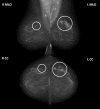ADMANI: Annotated Digital Mammograms and Associated Non-Image Datasets
- PMID: 37035431
- PMCID: PMC10077091
- DOI: 10.1148/ryai.220072
ADMANI: Annotated Digital Mammograms and Associated Non-Image Datasets
Abstract
Supplemental material is available for this article. Keywords: Mammography, Screening, Convolutional Neural Network (CNN) Published under a CC BY 4.0 license. See also the commentary by Cadrin-Chênevert in this issue.
Keywords: Convolutional Neural Network (CNN); Mammography; Screening.
© 2023 by the Radiological Society of North America, Inc.
Conflict of interest statement
Disclosures of conflicts of interest: H.M.L.F. Financial grant awarded by Australian Government Medical Research Future Fund (MRFF) funded development, in-kind support provided by the five partners (BreastScreen Victoria [BSV], St Vincent's Hospital Melbourne [SVHM], St Vincent's Institute of Medical Research [SVI], University of Melbourne [UOM], University of Adelaide [UOA]); honorary member of AI Advisory Committee for Royal Australian and New Zealand College of Radiologists. J.S.N.T. Employee of annalise.ai. M.S.E. No relevant relationships. K.M.K. No relevant relationships. B.H. Employed at SVI during 2021 and performed data engineering work for the results in this manuscript. R.K. No relevant relationships. C.F.K. No relevant relationships. C.A.P.S. No relevant relationships. Y.C. No relevant relationships. C.W. No relevant relationships. O.A.Q. No relevant relationships. S.K.F. No relevant relationships. S.L. No relevant relationships. E.M. No relevant relationships. T.L.N. No relevant relationships. D.F.S. National Breast Cancer Foundation Grant IIRS-18-093. P.B.R. No relevant relationships. J.F.L. No relevant relationships. P.B. Employee of annalise.ai. J.L.H. No relevant relationships. G.C. Employment at the UOA; project funded by MRFF grant; support for attending meetings and/or travel from MRFF grant; two patent applications. D.J.M. This manuscript arose from work supported by a grant awarded by the MRFF of Australia (no. MRFAI000090: BRAIx), grant payments made to author's institution and SVI and partially distributed to other partner institutions (SVHM, UOM, UOA, BSV); this work was also supported by a Ramaciotti Health Investment Grant from the Ramaciotti Foundation in Australia (Faster, cheaper, more accurate breast cancer screening: training computers to detect disease).
Figures



References
-
- American Institute for Cancer Research . Breast cancer . World Cancer Research Fund . https://www.wcrf.org/dietandcancer/breast-cancer/. Accessed August 11, 2021 .
-
- Australian Institute of Health and Welfare . BreastScreen Australia monitoring report 2020 . Australian Institute of Health and Welfare; ; 2020. .
-
- Morrell S , Taylor R , Roder D , Dobson A . Mammography screening and breast cancer mortality in Australia: an aggregate cohort study . J Med Screen 2012. ; 19 ( 1 ): 26 – 34 . - PubMed
-
- Rodríguez-Ruiz A , Krupinski E , Mordang J-J , et al. . Detection of breast cancer with mammography: effect of an artificial intelligence support system . Radiology 2019. ; 290 ( 2 ): 305 – 314 . - PubMed
LinkOut - more resources
Full Text Sources

